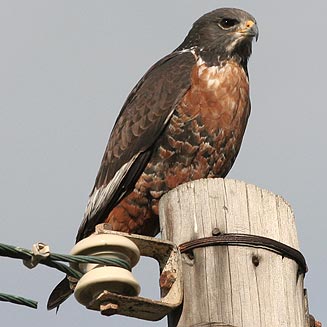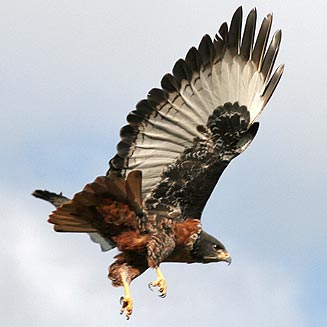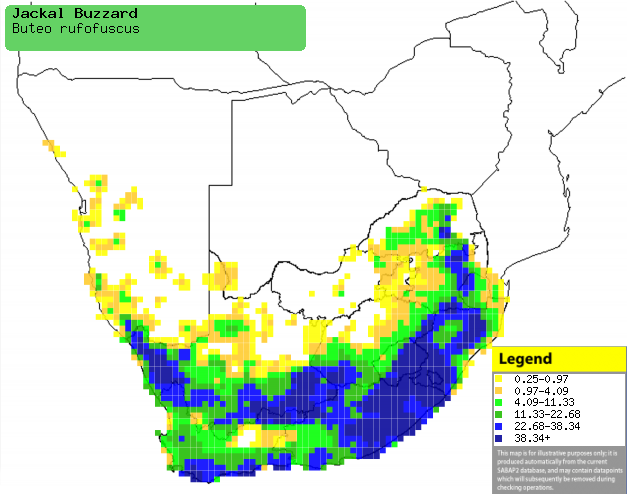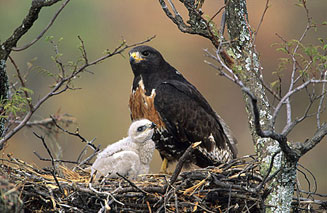|
Buteo rufofuscus (Jackal
buzzard)
Rooiborsjakkalsvoël [Afrikaans]; Indlandlokazi [Xhosa];
iNhlandlokazi, isiKhobotho [Zulu]; Khajoane (also applied to Steppe
buzzard), Tlatloatšoana [South Sotho]; Jakhalsbuizerd [Dutch]; Buse
rounoir [French]; Felsenbussard [German]; Bútio-de-cauda-vermelha
[Portuguese]
Life
> Eukaryotes >
Opisthokonta
> Metazoa (animals) >
Bilateria >
Deuterostomia > Chordata >
Craniata > Vertebrata (vertebrates) > Gnathostomata (jawed
vertebrates) > Teleostomi (teleost fish) > Osteichthyes (bony fish) > Class:
Sarcopterygii (lobe-finned
fish) > Stegocephalia (terrestrial
vertebrates) > Tetrapoda
(four-legged vertebrates) > Reptiliomorpha > Amniota >
Reptilia (reptiles) >
Romeriida > Diapsida > Archosauromorpha > Archosauria >
Dinosauria
(dinosaurs) > Saurischia > Theropoda (bipedal predatory dinosaurs) >
Coelurosauria > Maniraptora > Aves
(birds) > Order: Falconiformes
> Family: Accipitridae
> Genus: Buteo
 |
 |
|
Jackal buzzard, Kleinmond, Western Cape, South
Africa. [photo
David Robertson ©] |
Jackal buzzard, Kleinmond, Western Cape, South
Africa. [photo David Robertson ©] |
Distribution and habitat
Endemic to southern Africa, occurring from western and
southern Namibia and south-western Botswana to South Africa. It
generally prefers hilly or and mountainous areas with Karoo, fynbos, grassland,
open woodland or semi-desert. It is often found in habitats with short
vegetation, so it can be found in mountain ranges up to 3000 metres above sea
level, an elevation which few other raptors occur.
|
 |
|
Distribution of Jackal buzzard in southern Africa,
based on statistical smoothing of the records from first SA Bird Atlas
Project (©
Animal Demography unit, University of
Cape Town; smoothing by Birgit Erni and Francesca Little). Colours range
from dark blue (most common) through to yellow (least common).
See here for the latest distribution
from the SABAP2. |
Movements and migrations
Resident and locally nomadic, sometimes
travelling long distances in response to food availability.
Food
It mainly eats mammals, supplemented with birds and
lizards, doing most of its hunting from high up in the air or from a perch. Once
its spots something, it stoops to the ground to catch its prey, or alternatively
it can intercept birds aerially. It also scavenges at carcasses, especially in Winter
when food is scarce. The following food items have been recorded
in its diet:
- Vertebrates
- mammals
- birds
- reptiles
- frogs
- fish (scavenged)
- Invertebrates
Breeding
- Usually a monogamous, territorial solitary nester, although it has been
recorded to be polyandrous in the Lesotho highlands. In this area, one
female may mate with two males, who both of whom provide food for her and
defend the territory
from intruders.
- The nest is built by both sexes, starting up to three months before
egg-laying. The structure consists of a platform of thin branches, with a cup lined with
grass, leaves and lichen. It is typically placed on a ledge halfway up a
cliff, although it may also use the major fork of a tree, such as the
following:
- alien trees
- Pinus (pines)
- Eucalyptus
- Populus (poplars)
- Salix (willows
- indigenous trees
- Rhus (currants)
- Euphorbia
 |
|
|
Jackal buzzard at its nest with chick,
Bakoondkrans, Nylsvley area, South Africa. [photo
Warwick Tarboton ©] |
|
- Egg-laying season is from June-February, peaking from July-September.
- It lays 1-3, usually 2 eggs, which are mainly incubated by the female
for about 39-40 days, while the male feeds her regularly at the nest.
- The chicks are cared for closely by the female for the first two weeks
of their lives, while the male provides all the food. Thereafter, the female
joins the male out hunting. The older chick viciously attacks its younger sibling,
who inevitably dies before the end of the nestling period. The remaining
chick leaves the nest at about 50-53 days old, becoming fully independent a
few weeks later.
Threats
Not threatened.
References
-
Hockey PAR, Dean WRJ and Ryan PG 2005. Roberts
- Birds of southern Africa, VIIth ed. The Trustees of the John Voelcker
Bird Book Fund, Cape Town.
|
